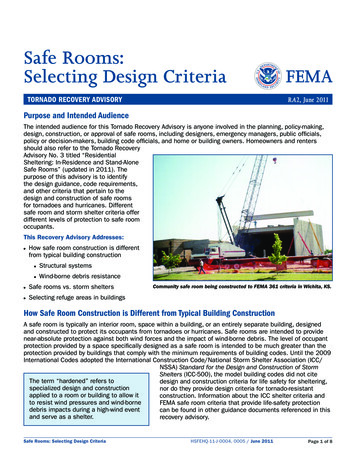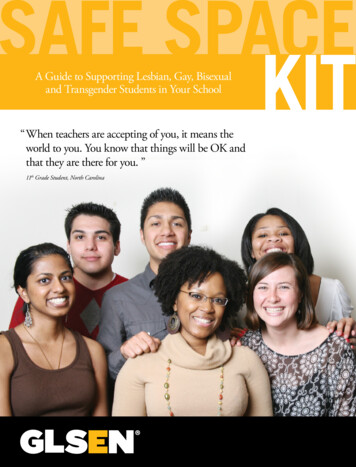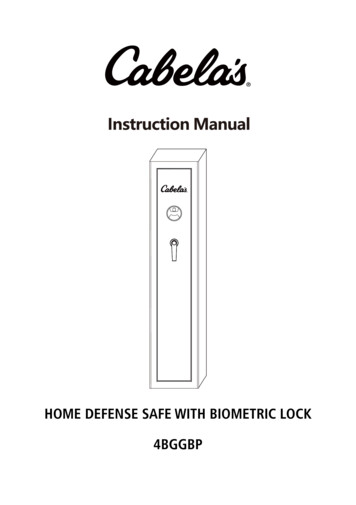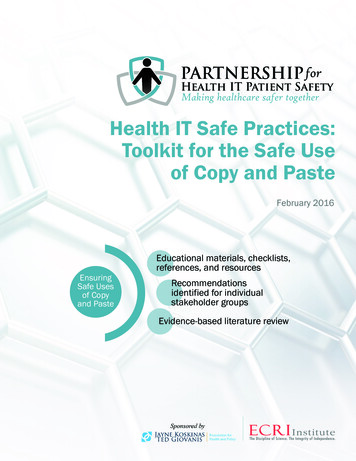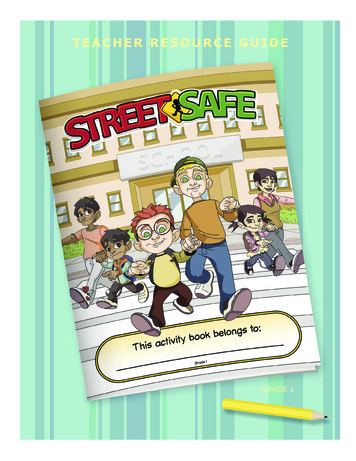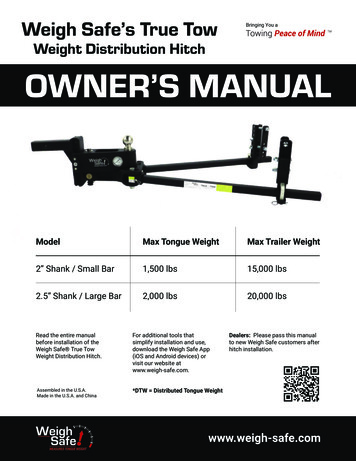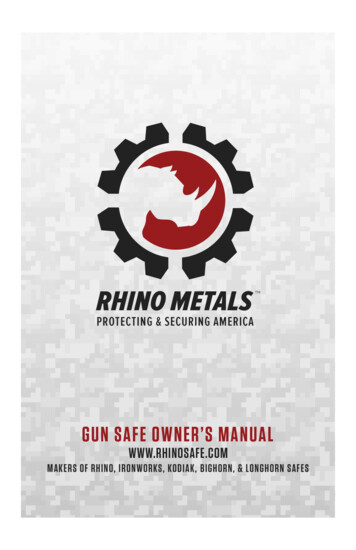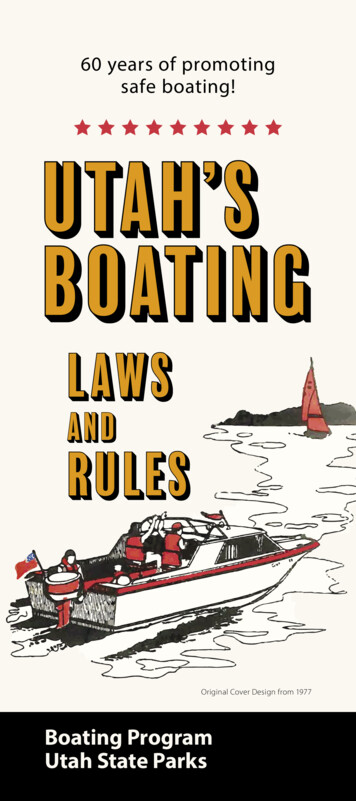
Transcription
60 years of promotingsafe boating!UTAH’SBOATINGLAWSANDRULESOriginal Cover Design from 1977Boating Program Utah State Parks
bbooaattiinngg.uuttaahh.ggoovvHyrum State Park23TABLE OF CONTENTSBOATING IN UTAH1REGISTRATION REQUIREMENTS3PADDLE SPORTS6EQUIPMENT REQUIREMENTS7PFD MANDATORY WEAR13OPERATION REQUIREMENTS19Speed and Proximity20Operator Age21SAFETY AWARENESS22SAFETY AND COURTESY TIPS31EMERGENCY PREPAREDNESS32
boating.utah.gov12BOATING IN UTAHUtah has some of the most beautifulwaterways in the nation, including theColorado River, Lake Powell, Bear Lake, andthe Great Salt Lake.With an ever-increasing demand onUtah’s limited number of rivers, lakes, andreservoirs, boaters must use their waterrecreation resources wisely. Boat ownersand operators have the responsibility toadvocate for and practice safe and ethicaluse of our waterways, including properlyregistering boats, learning and obeyingboating safety laws and rules, and sharingwaterways with other boaters, swimmers,and anglers.Utah’s Boating Program educates boatoperators about the laws and rulesestablished to provide public safety andprotect our natural resources. These effortsare funded by boat registration fees, statetaxes on fuel used in motorboats, andfederal boating safety grants. This brochureoutlines the basic responsibilities of Utahboaters. For a complete copy of Utah’sboating laws, contact the Utah Division ofParks and Recreation Boating Program.
boating.utah.govREGISTRATIONREQUIREMENTSWHAT IS CONSIDERED A BOAT?A boat is any type of watercraft capable oftransporting a person(s) on the water. Boatssuch as personal watercraft (PWC), rafts, canoes,kayaks, float tubes, inner tubes, kick boats, andstand-up paddle boards are subject to Utah’sboating laws and rules.DOES MY BOAT NEED TO BE REGISTERED?The assigned bow number must be displayed onthe boat with the decals, as shown in Figure 1.The yearly registration decals are to bedisplayed 3 inches from the last number on eachside of the boat. Only current yearly registrationdecals may be displayed. The month ofexpiration decals must be displayed immediatelybehind the yearly registration decals.Figure 1Starboard (right) side example with hyphensIf your boat has a motor (gas or electric) on it,or if it is a sailboat, it needs to be registeredand numbered. If you are visiting Utah (lessthan 60 days in a calendar year) and your boatis currently registered in your state, you do notneed a Utah registration.322223”UT-2628-BP2UT-2628-BPHOW DO I REGISTER MY BOAT?Port (left) side example without hyphensAll boat registrations are processed by the UtahState Tax Commission, Division of Motor Vehicles.To find an office near you, visit dmv.utah.gov.UT 2628 BP2”Space2”SpaceUT 2628 BPThe registration certificate must be carried onboard the boat for which it is issued, and must beavailable for inspection whenever the boat is onthe water.WHERE DO I ATTACH THE REGISTRATIONDECALS AND ASSIGNED NUMBERS?The assigned number must be displayed on eachside of the front half of the boat. Numbers andletters must be a solid color and block design,and at least 3 inches in height. The assignednumber must contrast with the background colorof the hull. Spaces or hyphens equal the widthof a letter, and must separate letter groups fromnumber groups. Numbers are read left to right.3”Space2222The currentyear ld notbe shown.2WHEN DOES MY BOAT REGISTRATION EXPIRE?Just like your vehicle registration, Utah boatregistrations expire annually, at the end of themonth in which the boat was originally registered.Owners who purchase boats from a dealer may beissued a 30-day temporary registration by the dealer.4
boating.utah.govWHERE IS THE HULL IDENTIFICATION NUMBER?The hull identification number (HIN) on all boatsbuilt after Nov. 1, 1972, is permanently fixed tothe rear of the boat, usually on the upper rightcorner. This number is required by federal lawand must appear on the registration application.The HIN consists of 12 letters and numbers atleast one-quarter inch in height indicating themanufacturer, hull serial numbers and/or letters,and model year and/or month.WILL MY BOAT BE TITLED?Yes, it is required to be titled only if your boat is1985 or newer. Boats built before 1985 or equippedwith motors less than 25 horsepower will not betitled by the Utah Division of Motor Vehicles.DO I NEED INSURANCE FOR MY BOAT?5Yes, Utah residents will need to carry owner oroperator liability insurance on motorboats andpersonal watercraft (PWC). Minimum insurancerequirements are: 25,000/ 50,000 bodilyinjury/death and 15,000 property damageor 65,000 combined minimum per accident.Motorboats equipped with engines less than50 horsepower and all air-boats are exemptfrom this requirement.Proof of insurance must be carried on-boardwhenever the boat is in operation.Non-Utah residents with a vessel registered inanother state must meet their state’s insurancerequirements or comply with Utah’s requirementswithin 90 days.Helpful Hint: Successful completion of a boatingsafety course at boating.utah.gov may lower boatinsurance premiums.PADDLE SPORTSPaddle sports are taking off in Utah, whetheryou are new or experienced in this activity, itcan be a great source of exercise, or an escapeto be one with nature. Hazards do exist, and itis your responsibility to keep yourself, and thoseyou are with, safe while out on the water. Hereare some laws and tips you need to know to besafe out there. All stand up paddle-boards (SUP), kayaksand canoes must have at least one U.S. CoastGuard-approved wearable or inflatable lifejacket for each person on board. Those 12years of age and younger must wear a lifejacket at all times. E xpect to capsize and swim occasionally - it’spart of the sport. But when it’s unexpected,a life jacket will be needed, even if you are agood swimmer. It will provide flotation, so youcan concentrate on re-boarding your craft. Itwill also provide extra insulation in cold water. Place all your extra gear (drinking water, snacks,sunscreen, bug repellent, electronics, etc.) intoa dry bag and secure it to your craft. Dress in layers that are quick-drying and wickmoisture away from the body. Wear a leash (if applicable to your craft) or leashyour paddle. There is a chance the wind mayblow your craft or paddle away from you.6
boating.utah.gov Wear brightly colored clothing to assist you tobe seen by other boaters. Carry a whistle and flashlight to signal otherboaters. Stay away from low head dams, strainers, andhigh water flows. Always consider your abilitiesto navigate every water condition you are in, orapproaching. Your craft does not need to be registered inUtah unless a motor or sail is attached. Take a paddle sports education class. Thereare many courses out there that provide greatsafety information.EQUIPMENT REQUIREMENTS7WHAT SAFETY EQUIPMENT DO I NEEDON MY BOAT?Life Jackets (Personal Flotation Devices or PFDs)Life jackets save lives! In Utah, and nationally, 80%of people who drown in boating accidents wouldhave survived if wearing a life jacket.The Division of Parks and Recreation BoatingProgram recommends that all boaters andpassengers not only have a life jacket, but wearit at all times while on the water. Accidents canhappen, and do so too fast to find and put on alife jacket.Utah law requires that all boats have at leastone wearable U.S. Coast Guard-approved lifejacket of the proper size, in good and serviceablecondition, and readily accessible for eachperson on board. All life jackets must be used inaccordance with the age, weight, activity, anduse restrictions listed on the U.S. Coast Guardapproval label.There are many different kinds of lifejackets out there, and you should know thedifferences. Inflatable Suspender orBelt/Waist Pack Some models automaticallyinflate when submerged in thewater. All models can be inflatedmanually or inflated by mouth. Not for use on rivers, PWC’s,being towed behind a boat, orby persons under the age of 16. Great for fishermen and generalpassengers.Adult to Child Buoyancy Vest Covers a variety of uses, andshapes, sizes, and colors.Infant to Child Buoyancy Vest Covers a variety of uses, andshapes, sizes, and colors. Throwable PFD Boats 16 to 39 feet in lengthmust carry at least onethrowable PFD; boats 40 feetand greater must carry at leasttwo throwable PFDs. Type IVthrowable PFDs need to beplaced in plain sight where theycan be quickly accessed.Pet Buoyancy Vest8
boating.utah.govSo which life jacket should I buy?You should buy one that you will wear! It mustfit you properly, and be approved for the activityyou are participating in.First Read the LabelThere are two types of labels you will see whenbuying a life jacket. One designates the type andone designates performance. The new label thatdesignates performance is approved for use inthe United States and Canada, while the old labelthat designates type is only approved for theUnited States.The old U.S. Coast Guard typing codes arestill valid, and will be for some time.IIIIIIIVType I PFD (Wearable): Provides the mostbuoyancy and turns most unconscious wearers toa face-up position.9Old LabelNew LabelHere are some things to look for and dowhile reading a life jacket label. Is it approved by the U.S. Coast Guard? Check the label to make sure it matches yourweight and chest size. Try it on! Make sure the fit is secure, comfortable,and adjustable. Is it comfortable enough that you will wantto wear it? A sk where will I be wearing this life jacket?Type II PFD (Wearable): Turns some unconsciouswearers to a face-up position.Type III PFD (Wearable): Designed so wearers canplace themselves in a face-up position.Type IV PFD (Throwable): Designed to be thrownto a person in the water, grasped and held by theuser until rescued.Type V PFD (Wearable): Designed and approvedfor specific activities on the approval label, andonly counts as a life jacket while worn.10
boating.utah.govLeaving your life jacket on shore does no one any good.New US Coast Guardlabel performance designationYou will find other icons on this new label sowhat do they mean?When choosing a life jacket with these symbolsconsider your activity and environment youwill be in. Life jackets with the new label have aperformance icon measured in newtons. Warning T his life jacket is not designed foruse on personal watercraft.1112 T his life jacket is not designed foruse when water skiing.What does that mean to you? Lower performance numbers offer greatermobility, comfort, and style with good flotationfor most people. Higher performance numbers offer greaterflotation, turning, and stability in the water. T here are areas where you may be boating nearshore when rescue is hours away, and a higherlevel is needed. Be honest about your swimming ability. Poorswimmers may need a higher level to stayupright and easily tread water. T his life jacket is not designed foruse when participating in similartowed uses. T his life jacket is not designed foruse in whitewater.Any life jacket that has a rip or tear, frayed straps,and broken pieces should be thrown away.
boating.utah.govPassengers 12 years of age and younger mustwear a properly sized and approved wearablelife jacket when the boat is on the water.Children are not required to wear life jacketswhile inside an enclosed cabin area of a boat 19feet or more in length.Each person being towed on water skis orother devices, wake surfing, operating or ridingon a PWC must wear a properly sized andapproved life jacket.13On rivers, every person on any vessel including,inner tubes must wear a properly sized andapproved life jacket. For persons older than 12years of age, life jackets may be loosened orremoved only while on designated flat waterriver sections. Contact the Utah Division of Parksand Recreation Boating Program for a listing ofdesignated flat water river sections in Utah.Wear it Utah! Life jackets buy you time!FIRE EXTINGUISHERSAll motorboats must carry a serviceable U.S.Coast Guard or Underwriters Laboratory (UL)marine approved fire extinguisher. There are twotypes: rechargeable and disposable.Rechargeable fire extinguishers have metaltops and need to be serviced every five yearsaccording to the date on the label. If it isdischarged, it needs to be recharged or replaced.Disposable extinguishers have plastic tops anda 12-year expiration date (see label or bottom).If discharged, it needs to be replaced.Depending on the size of your boat, you willneed to carry more than one extinguisher: Less than 26 feet in length: One B-I 26 feet to less than 40 feet in length:Two B-I or one B-II 4 0 feet to less than 65 feet in length:Three B-I or One B-I and One B-II 65 feet in length and greater: One fixedsystem in the engine compartment and threeB-II placed at the helm, kitchen, and enginecompartment.Marine Fire Extinguisher ClassificationClassification (Type-size)Foam (Minimum gallons)Carbon Dioxide (Minimum pounds)Dry Chemical (Minimum pounds)Halon/Freon (Minimum pounds)B-I1.25422.25B-II2.51510–FoamCarbon Dioxide or Halon/FreonDry ChemicalExemption: Outboard motorboats of openconstruction are not required to carry a fireextinguisher. Open construction means no closedcompartments where portable fuel tanks may bestored; a double bottom that is sealed to the hull orcompletely filled with flotation material; no closedliving spaces: no closed stowage compartmentsin which combustible or flammable materials arestored; no permanently installed fuel tanks.14
boating.utah.govVENTILATIONGasoline-powered boats with covered motors(inboard or inboard-outboard) need properventilation to remove dangerous and explosivevapors from enclosed engine and fuel tankcompartments. Gas vapors are heavier than airand will pool in the bottom with no escape.Be sure the boat is well ventilated (3- 4 minutes)before starting the engine, especially afterrefueling.BACKFIRE FLAME CONTROLAll inboard gasoline engines must be equippedwith a U.S. Coast Guard or UnderwritersLaboratory (UL) approved backfire flame arrestoron the carburetor.Motorboats or Sailboats adrift or at anchormust display an all-round white light unlessanchored in a designated mooring area.Non-navigation lights may only be displayedunder 3 conditions: 1) a spotlight or other nonnavigational light may be used intermittentlyduring docking or to locate a hazard, or 2) duringa federal or state-permitted marine parade, or 3)a spotlight or other non-navigational light maybe used when actively engaged in fishing, bowfishing, or scientific research on board boats thatare not in a navigational channel and that arebeing operated at a wakeless speed.Figure 1Figure 2Figure 3NAVIGATION LIGHTS15All boats must display navigation lights whileoperating between sunset and sunrise.Motorboats less than 40 feet must displaynavigation lights as shown in figures 1, 2, or3. Motorboats 40 to 65 feet long must displaynavigation lights as shown in figures 1 or 2.16orFigure 4Figure 5ororSailboats must display navigation lights as shownin figures 4, 5, or 6. Sailboats under power mustfollow motorboat navigation light requirements.Manually propelled boats may display eithernavigation lights required for sailboats, or a whitelight (flashlight or lantern) that shall be displayedin sufficient time to prevent a collision.See figure 7.Personal Watercraft (Jet Skis, Waverunners,Sea-Doos, etc.) may not be operated betweensunset and sunrise, they may not be equippedwith navigation lights.ororFigure 6Figure 7Visible RangeLocation of Lights on VesselLess than 40 ft.40 ft.-60 ft.Degrees of Arc LightsMasthead2 miles3 miles225 All-round2 miles2 miles360 Side Lights1 mile2 miles112.5 (each color)Stern Light2 miles2 miles135
boating.utah.govHORN OR WHISTLEBoats from 16 to 39 feet long must have a hornor whistle capable of producing a four-to-sixsecond blast of sound. Boats 40 feet or greatermust have a horn or whistle and a bell. A horn orwhistle is recommended for boats less than 16feet in length.BAILING DEVICEAll non-self-bailing boats must carry a bailbucket, or bilge pump. It is a good idea to carryboth in case one fails.SPARE PROPULSIONBoats less than 21 feet long must have at leastone spare paddle, oar, or motor on board.MUFFLERS17All motorboats must be equipped with and use amuffler system in good working order to preventexcessive noise. Motorboats manufactured beforeJan. 1, 1993 cannot exceed 90 decibels; after 1993cannot exceed 88 decibels. Muffler cutouts orbypass systems are prohibited.MARINE TOILETSPump it, don’t dump it! It is illegal to deposithuman waste into Utah’s waters or adjacentlands. Marine toilets must be emptied atdockside, or other approved sanitation facilities.Keep Utah’s waterways clean and beautiful bynot littering or polluting in or around them.Pump It!Don’t Dump It!OTHER EQUIPMENT SUGGESTIONSBoat owners and operators are advised to carryflashlights, first-aid kits, boarding ladders, toolkits, extra line (rope), spare spark plugs, sparebilge plugs, spare propellers, anchors, andapproved visual distress signals. Cell phones. GPSunits and marine band radios have proven vital inmany rescue situations.AQUATIC INVASIVE SPECIESInvasive quagga and zebra mussels are a majorthreat to our quality of life. They are small, clamlike creatures that reproduce rapidly and causesignificant economic impacts. They destroyfisheries, ruin shorelines and beaches, damageboats and equipment, and clog water deliverysystems, costing millions of dollars to control.It is illegal to possess or transport invasivemussels, including any water from infestedwaters. You must pull all drain plugs and drainall water from your boat before transport withinUtah. If coming from an infested water, you mustmeet either the seasonal dry time requirement orundergo professional hot water decontamination.If you are a boater from another state you mustpay a non-resident aquatic invasive species feeand complete an education course annually. Formore information, visit stdofthesea.utah.gov.18
boating.utah.govA person operating a motorboat on Utah’s watersis considered to have given consent to take anyfield sobriety test requested by a peace officerwho feels the person is operating under theinfluence of alcohol and/or drugs. If arrested,your boat, trailer, and tow vehicle may beimpounded.WHAT ARE BOATING STRESSORS?20150feet1 5 0 fe eSwimAreaNatural boating stressors such as the brightness,heat, and glare of the sun; noise and vibrationof the boat; motion of the boat with the windand waves; and even darkness; can affect a boatoperator’s coordination, judgment, and reactiontime. After four hours on the water, these stressorswill produce a reaction time similar to having ablood alcohol content of 0.10. Rest frequently onland to reduce the effects of these stressors.tet19Alcohol is allowed on all boats; however, it isagainst the law for a person under the influenceof alcohol and/or drugs to operate a motorboat.Boating under the influence (BUI) is the same asdriving under the influence (DUI) and has thesame penalties including suspension of driverlicense, possible jail time and fines. Please drinkresponsibly!Yes! A wakeless or idle speed is required whenoperating a boat in a designated slow, wakelessspeed area and within 150 feet of another boat,person in the water, a water skier (except thoseyou are towing), shore angler, launch ramp,dock, or designated swimming area. You areresponsible for any injury or damage caused byyour boat’s wake. Be courteous and give othersplenty of room.feDON’T DRINK AND DRIVEIS THERE A SPEED LIMIT ON THE WATER?50OPERATION REQUIREMENTS1
boating.utah.govHOW OLD MUST A PERSON BE TO OPERATE AMOTORBOAT OR SAILBOAT?Persons under 16 years of age may operate amotorboat or sailboat when accompanied andunder direct supervision of a responsible person18 years of age or older.HOW OLD MUST A PERSON BE TO OPERATE APERSONAL WATERCRAFT (PWC)?SAFETY AWARENESSChildren ages 12 through 17 may operate aPWC (Jet Ski, Waverunner, Sea-Doo, etc), uponcompletion of a Utah Division of Parks andRecreation approved boating education course.In addition, those between 12 and 15 yearsmust operate under the direct supervision ofa responsible adult at least 18 years of age. Aperson less than 18 years of age who has not metthe above requirements may not operate a PWCunless accompanied by a responsible adult.Carbon Monoxide - Known as thesilent killer, this gas is odorless and tasteless and can deplete your oxygento the point of death. Do not allow anyone tospend time around the back of the boat whilethe engine is running.21Education courses are available at boating.utah.gov.WHAT IS MEANT BY DIRECT SUPERVISION?Direct supervision means supervision withinsight, at a distance in which visual contact canbe maintained by the adult responsible for theyoung boat operator.CARBON MONOXIDEFACTS Carbon monoxide (CO) is a deadly gas emittedthrough the exhaust ports in the rear of theboat when the engine is on or idling. CO is colorless, odorless, and tasteless andcan kill in seconds. It enters the bloodstreamthrough the lungs and displaces the oxygenyour body needs to breathe. Early symptoms of CO poisoning includeirritated eyes, headache, nausea, and dizziness.These symptoms are often confused withseasickness or intoxication. Prolonged exposure to low CO concentrationsor very short exposure to high concentrationlevels can lead to death. Every year, boaters and children are injuredor killed by CO in the boat’s cabin or otherenclosed areas, and in the rear of the boat on oraround the swim platform where there can behigh levels of CO. Any boat with an engine or generator canendanger passengers.22
Carbon monoxide from exhaust pipes of inboard enAVOID THESE DEATH ZONES!gines, outboard engines and generators builds up insideand outsideboatareasnearexhaustvents.Swimmingnear or theunderthe inbackdeckor ),sitAVOID THESE DEATH mingthe orbackdeckor latform.gines,enginesandgeneratorsbuildsup inboatwhen theenginesareoperatingbe deadlya swimthedeckoroutboardplatformwhereexhaustis vented,not cansideandoutsidetheboatin ofareasnearvents.withinminutes.evenmonoxidefora second,even exhaustif theengines/generatorsare exhaustCarbonfrompipesinboardenCarbon monoxidefrom (alsoexhaustpipesofinboard andhavebeenoffforalongtime.Exhaustlingersgines, outboard engines and generators builds up yin-area implatformorswimmingside and outside the boat in areas near exhaust vents.side tformwhereiscanvented, notcontaminatedairin orthisthe“deathchamber”toexhaustkill a vents.boatwhenenginesaredragging”),operatingTeak ofsurfing(alsoknownas“platformsit- be deadlyTeak inutes.or swimming directly behindting on thewithinswim platformting on theoffswimor swimmingdirectlybehind lingers inandplatformhave beenoff for a longtime. Exhaustthe boat when the engines are operating can be deadlythe thsofunderconwithin inDOminutes.a swim deckor thisplatformexhaustnottaminatedair in“deathwherechamber”to killis avented,swimmer.motor orgeneratoroperating.On calmdays,wait atevenfor a issecond,evenif theengines/generatorsareNEVERenteran enclosedor O sa swim deck or platform where exhaust is vented, nota swimdeckorwhereexhaustisvented,notor ts.sit,beforeor platformstandin thesewhenthemotorareas,andonlytakesoneor twobreathsof coneven for a suchsecond,evenifittheengines/generatorsareeven for ng.Oncalmdays,waitatleast15minutestaminatedthis “deathchamber”to killina swimmer.off and havebeen off airforina longtime. Exhaustlingersoff andhavebeenfor a orlongtime. Exhaustlingersin off beforeafterthemotorgeneratorhas beenshutSideViewofaoffHouseboatsuch areas, and it only takes one or two breaths of consuch areas,occupyingand AWAYit onlyopentakesopenone exhaustortwobreathsof conSTAYfromvent areas.DO NOT .taminated air in this “death chamber” to kill a swimmer.taminated air“deathchamber”kill atheswimmer.sit,inorthisstandin theseareastowhenmotor or generaDANGER! Air Pocket& WaterUnderStep 15 minutestor is openoperating.Onventcalmareas.days,waitat leastSTAY AWAY fromexhaustDONOTswim,STAY AWAY fromopenexhaustventareas. DONOTswim,afterthemotororgeneratorhasbeenshut off beforesit, or stand in these areas when the motorSwimor Platformgenerasit, or standoccupyingin theseareaswhenthemotoror vents.generaGeneratorExhaustSystemExhaustVentfrom Generatoropenareasnearexhausttor is operating.On calm days, wait at least 15 minutesGenerator Sidetor is operating.OnViewcalmwait at least 15 minutesof adays,Houseboatafter the motor or generator has been shut off before23after the motor or generatorbeforeAir PocketPort Engine has been shut offDANGER!occupying open areas near exhaust vents.occupying open areas near exhaust vents. Below& Water Under StepWater LevelEnclosedSideExhaustView ofAreaa HouseboatExhaust Vent from GeneratorSwim PlatformGenerator Exhaust SystemExhaust Vent fromDANGER!GeneratorAir PocketExhaust Vent from&GeneratorWater Under StepGeneratorSide View of a HouseboatPort EngineSide View of a HouseboatAir PocketSwimming, teak surfing, dragging andDANGER!water skiingwithinBelow PlatformWater LevelDANGER! Air PocketSwim&WaterUnderStep20 feet of a moving watercraftcanbefatal.Generator Exhaust System& Water Under StepGeneratorEnclosedExhaust AreaGeneratorGeneratorGenerator Exhaust SystemGenerator Exhaust SystemPort EngineSwim PlatformSwim PlatformBelow Water LevelTeak surfing,dragging and water skiing within 20 feetPort EnginePort EngineEnclosedExhaustAreaof a moving watercraftcan be fatal.Below Water LevelBelow Water LevelEnclosed Exhaust dragging and water skiing within 20 feetof a moving watercraft can be fatal.Teak surfing, dragging and water skiing within 20 feetTeak surfing, dragging and water skiing within 20 feetof a moving watercraft can be fatal.of a moving watercraft can be fatal.Open Exhaust Area CARBON MONOXIDEOpen Exhaust Areaand cockpit area - eBlockagewindows,of nandcloseaccumulatein tBlockage ageexhaustcockpitarea cancauseofExhaustcarbonmonoxidefrom windowstoaccumulateinthecabinthat inis docked,beatocarbonaccumulatethe cabinmonoxideanddoorsarewhenclosand o accumulatein - evenhatches,windows,portholesboatcanemit poisthe passengerarea- tfromanotgevenwhenhatches,monoxideand doors carbonare closed.windows, portholes,thatcabinis docked,beatheand cockand doorsfromareclosed.anchoredyourboat. alongsidEvenwiExhaustanothervesselExhaust at is docked, beached, orthat is docked,beached,orcarbonmonoxideshouldbe a manchored boatalongsideyouranchored alongsideyourthecabinand cockof20poisonousfeet fromtheboat can emitboat can emitpoisonousyourboat.Evenboatthatisrunningcarbon monoxide gas into wcarbon monoxidegas intoerlycockpitventedexhaueratoror engine.the cabin andofthe cabin andcockpitofbe a myourboat. boatEvenshouldwith propExhaust from another vessel thatyouris lyventedexhaust,youror anchored alongside your boaterlycan ventedemit poisonousSlowspeedsor idlinexhaust,yourboatis runninboat shouldathatminimumcarbon monoxide gas into the passengerareaofbeyourthewatercan causeboat shouldbeaminimumeratorornearestengine.boat. Even with properly vented exhaust,yourboattheof 20 feetfrommonoxidegas to acof 20 feet fromthe nearestshould be a minimum of 20 feet fromnearestboat a genboatthethatisrunningthe cabin,cockpboat that isinrunninga genthat is running a generator or engine.erator or engine.Slowor idlandaftspeedsdeck, evenerator or engine.the watercan causarea.A tailwind(foSlow speeds or useidling inin thespeedswater canSloworidlingin cockp24inthecabin,tionofgasthe carbonmotorbothewatercan k,evenalsoincreaseaccummonoxidegastoaccumulateto ndin the cabin,bridge,(foareacockpit,andinpassengerthe cabin,cockpit,bridge,windenteringfromaft deck,eveninan in anandaft deck,evenopenTheeven“stationwagonand aft deck,inanopenof(forcethe motorbopen area.Ationtailwindarea.A tailwindof canorbackdraftingarea.Aoftailwind(force romaft sec- ionof torboat)canmotorboat) itandbridgealsoalsoincreaseincrease accumulation.or backdraftingcaoperatingthe boataccumulation.carbonmonoxidebowangle,with”
Non-Utah residents with a vessel registered in another state must meet their state's insurance requirements or comply with Utah's requirements within 90 days. Helpful Hint: Successful completion of a boating safety course at boating.utah.gov may lower boat insurance premiums. PADDLE SPORTS Paddle sports are taking off in Utah, whether
